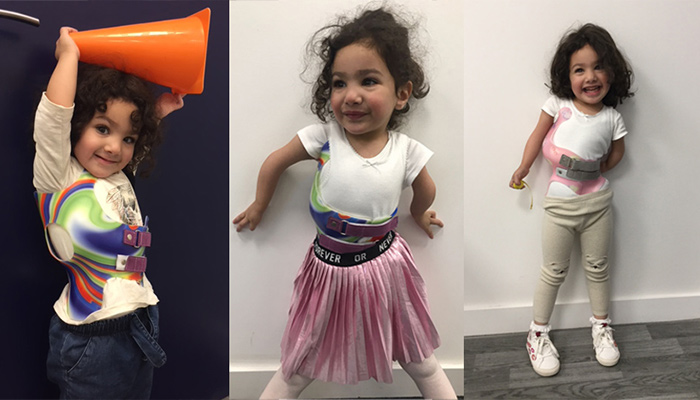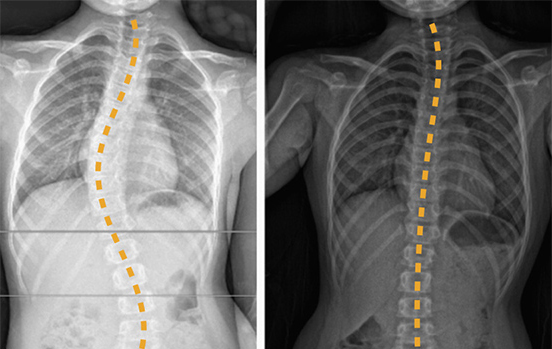Juvenile idiopathic scoliosis is typically defined as scoliosis that is first diagnosed between the ages of 4 and 10. This category comprises about 10% to 15% of all idiopathic scoliosis in children.
At the younger end of the spectrum, boys are affected slightly more than girls and the curve is often left-sided. Towards the upper end of the age spectrum, the condition is more prevalent in girls and the curve tends to be right-sided.
Children with juvenile scoliosis generally have a high risk of progression of their curve. Seven out of 10 children with this condition will worsen and require active treatment with scoliosis bracing.
Note, juvenile idiopathic scoliosis is different to infantile idiopathic scoliosis, which is diagnosed in children between birth and 3 years of age. Infantile scoliosis accounts for fewer than 1% of all scoliosis cases in children.

One of our juvenile scoliosis patients was two years old when we first braced her. Her primary curve reduced from 44 to 27 degrees in 4 months. From left: first brace fitting, review of first brace and second brace fitting.
In juvenile scoliosis, where there are curves between 10 and 25 degrees, Schroth physiotherapy may be able to make some corrections or control the curve. However, once the curve is greater than 25 degrees it is usually too large for physiotherapy alone to manage and physio in conjunction with scoliosis bracing is recommended.
As with adolescent scoliosis, we treat juvenile scoliosis with our own bespoke version of the Cheneau brace, the LOC Scoliosis Brace. which takes a three-dimensional approach to the treatment of scoliosis combined with Schroth-based physiotherapy principles.
Depending on the age of the child, parents may need to help them follow their recommended postural activities. Once correction of the curve has been achieved, scoliosis bracing may be discontinued for one or more years with a return to observation. As the child begins an adolescent growth spurt, it is likely that they will need to be re-braced to maintain the previously achieved correction of the curve.

These scans are from a three-year-old boy with juvenile idiopathic scoliosis. He first came to us with a single thoracic curve and was hypermobile. He was fitted with a bespoke Cheneau-Gensingen brace and had custom foot orthotics fitted to aid with his hypermobile pes planus (flat feet). Overall, he responded very well to bracing.

The LOC Scoliosis Brace takes a three-dimensional approach to scoliosis treatment. This type of bracing is regarded by many scoliosis clinics around the world as the preferred alternative to surgery, since it has been proven to reduce Cobb angles and improve posture.

Our bespoke scoliosis treatment can be combined with a comprehensive physiotherapy programme that adheres to the principles of the world-renowned Schroth treatment.
Our treatment package price includes all reviews and on-site adjustments of the brace by our certified orthotists.

There may be cancellations or delays to your child’s spinal surgery for several reasons. At LOC, we are here to assist where possible. Using our corrective LOC Scoliosis Brace, we can halt the curve's progression, balance posture and reduce any back pain.

Join The London Orthotic Consultancy in celebrating Cerebral Palsy Awareness Day on March 25th. Learn just how important expert orthotic care is in enhancing mobility, independence, and quality of life for children and adults with cerebral palsy.

Introducing the Agilik™ smart orthosis, a cutting-edge, powered knee orthotic now available in the UK through the London Orthotic Consultancy. Unlike traditional KAFOs or heavy exoskeletons, the Agilik™ provides dynamic knee assistance and offers real-time support, reducing fatigue and improving posture. This pioneering, modern technology can help children and adults with lower limb weakness walk more efficiently and naturally. We are honoured to be selected as the exclusive paediatric specialist centre in the UK for the Agilik™ device.

When Sophie noticed her baby Max had a persistent flat spot on his head, she was told it would resolve naturally—but it didn’t. Seeking a second opinion led her to the London Orthotic Consultancy, where Max was diagnosed with severe plagiocephaly.

A little more than four years after the LOCband Lite's launch, we're proud to have successfully treated our 250th helmet therapy patient at our Romford clinic using our cutting-edge 3D-printed cranial band. After five months of treatment, her final scan showed that her asymmetry had decreased from 12 mm to 3 mm.

Sky News published an article this month quoting scientists at Southmead Hospital who claimed there was a lack of research into flat head syndrome and its treatment with cranial remoulding (helmet) therapy. This is our response.

With our non-surgical treatment plan, Alex achieved 100% chest correction in just two years. His treatment involved a combination of dynamic chest compressor and vacuum bell therapy treatment to address his pectus excavatum and rib flaring.

Learn how a custom carbon fibre AFO helped Gill regain mobility and comfort despite complex challenges from shin bone (tibia) removal. We created a truly tailored orthotic solution made from pre-preg carbon fibre at our Cambridge clinic.

Discover how bespoke orthotics and the OSKAR program with Elaine Owen transformed Archie’s life with cerebral palsy quadriplegia, helping him avoid a wheelchair and achieve greater mobility.